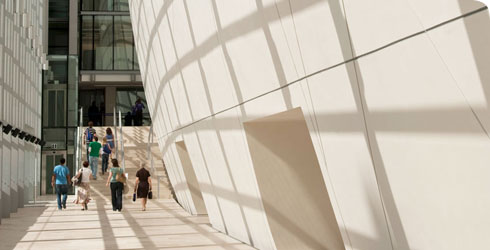What is the Museum doing?
As a Museum about the natural world, we are very aware of the effect of humans on the environment, and the need to preserve it.
We are continually introducing practical ways of reducing our carbon footprint. As well as reducing the amount of energy we use and our carbon emissions, many of these actions also help us improve our effect on local air quality.
Heating
The Museum is a large building with nearly 1000 members of staff, and millions of visitors a year, so an efficient heating system is particularly important.
All of the heating, air-conditioning and other electrical appliances at the Museum are powered by our Combined Heat and Power plant. This provides energy much more efficiently than conventional methods.
Most buildings use energy that was generated far away and much of it is lost on route. By having an on-site energy centre, the Museum overcomes this problem.
If the building becomes too hot in summer, the waste heat from our air conditioners is captured instead of being allowed to escape. Through a clever chemical process, using only a saline solution and no harmful chemicals, this waste heat is turned into chilled water. This makes sure that the energy we generate isn’t wasted.
Locally sourced materials
Transporting heavy building materials over long distances generates a lot of carbon dioxide. This is why the Museum’s landmark Darwin Centre was built with local materials wherever possible. The stone for the atrium comes from Portland on the south coast of Britain.
All the other materials used in the state-of-the-art centre were also sourced sustainably, wherever possible.
Recycling
The Museum has a strict recycling policy. Plastic, paper and cardboard used inside our buildings are all stored separately from general waste so they can be recycled.
Building materials are also recycled wherever possible. When the Museum’s old entomology building (which housed the insect collections) had to be demolished, around 95% of the materials were re-used in the Darwin Centre and elsewhere.
80% of materials that had to be removed from the Darwin Centre site were recycled.
Energy efficiency
All the lights in our offices, the Darwin Centre and where possible in other public spaces, use energy efficient bulbs. There are lighting control systems to make sure that the lights are only turned on if a room is occupied and the natural light levels are too low.
Design of the Darwin Centre
The Darwin Centre was designed and built to have the minimum impact on the environment.
The concrete structure of the cocoon acts as a heat reservoir, which is well insulated from temperature changes during hot days or cold nights. This allows the important collections of plants and insects to be kept in a stable environment with minimal use of heating and air conditioning.
Areas of the atrium surrounding the cocoon that regularly have people in them have strictly controlled temperatures. However, areas that do not have people in them very often have a variable temperature. So, energy is not wasted on heating or air conditioning them unnecessarily.
To avoid over-heating, the glazing on the west side of the building is etched, to reduce the amount of the sun’s heat that gets inside.
Ongoing carbon saving
The Museum encourages all staff to reduce the energy they use at work, for example, by making sure that lights and computer screens are switched off whenever they are not in use.
We are always looking for ways to make sure we continue to cut our energy use.

